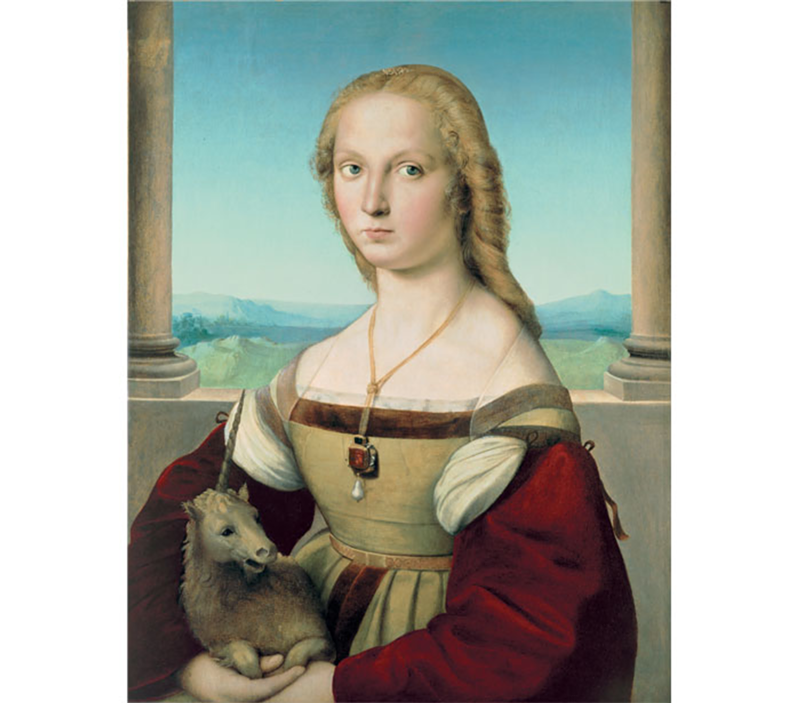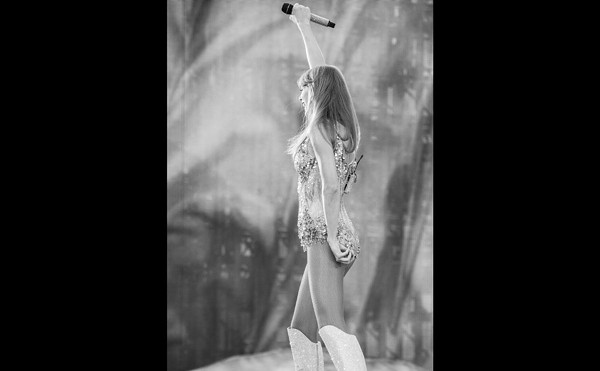The Cincinnati Art Museum’s new show, Sublime Beauty, marks the very first time Raphael’s “Portrait of a Lady with a Unicorn” has visited the United States, itself a reason for celebration (it was loaned by the Galleria Borghese in Rome, which acquired the painting in 1682). Like many masterpiece portraits, the painting occupies both a realm of intense clarity and ambiguity, the former made possible by Raphael’s courageous use of color and sumptuous detail, the latter owed to historical and scholarly discrepancies.
I’ll admit that I was not entirely prepared to view and review an exhibition that consists of only a single painting, as is the case with Sublime Beauty. Of course, the act of showing only a single work automatically lends an air of authority and importance, but it also allows more room for scrutiny — for the viewer to interrogate the piece with his or her imagination.
The painting is equipped with a catalog of vagueness. There is the fact that until the 1930s the painting’s true author was unknown. And the fact that there are disagreements surrounding whom exactly the portrait depicts. Perhaps most fascinatingly, it was discovered in the early 20th century that someone had painted over the portrait, recasting the sitter as St. Catherine, complete with the famous wheel upon which she was to be tortured. Restoration attempts later resurfaced Raphael’s “Portrait of a Lady with a Unicorn,” and subsequent X-rays of the High Renaissance painter’s oil work showed that a dog had been painted before the unicorn. Some scholars have proposed that Raphael actually left the painting unfinished, suggesting that both the dog and the unicorn had been layered over some time later by another artist.
This series of pentimenti invites us to explore that word’s concept. Pentimento, an Italian term used to describe a visible change made during the painting process, suggests a reconsideration. It is now thought that “Portrait of a Lady with a Unicorn” was a bridal gift to friends of the painter, whose movement favored harmonious and serene portrayals of beauty. The hesitancy of the painting’s pentimenti coupled with the fact that this was a gift only adds to the unknowability of Raphael’s masterwork.
Then there is the subject herself, instantly reminiscent of another enigmatic woman who posed for a three-quarter portrait in the early 16th century. But unlike da Vinci’s “Mona Lisa” and her smile, this sitter’s tight-lipped expression hints at disapproval. Cradling the black-eyed unicorn foal, her eyes are untrusting blue saucers caught mid-roll, refusing eye contact.
A common myth said that only virgins could tame a unicorn, a symbol of chastity, but the exhibit can tell you better than I about the painting’s symbolism. The curators can’t solve some of the portrait’s underlying mysteries, but they do their best to keep viewers informed with text describing the relevant mythologies and stylistic flourishes. A timeline tracks the work throughout its existence, from when it was first painted on wood to its restorations and revelations.
Raphael’s colors are feats in and of themselves; the lady’s robes are a luminous incarnadine, the braid pulled behind the slope of her pale shoulders a glimmering blonde. A horizon is leveled behind her, an ombré sky turning deep aqua at the top of the canvas. Quarantined by itself in the dark gallery, the painting takes on a glowing appearance.
If the point of art reviews are to recommend, then yes, I heartily recommend seeing “Portrait of a Lady with a Unicorn”— unless you’re able to visit San Francisco (the other city it’s traveling to) in the spring, you’ll have to make a pilgrimage to Italy after this. But the CAM is offering an experience.
Sometimes witnessing the most “effective” art can feel like a burglary, like the art is taking a piece of you. Often this is indescribable. Though it bears striking similarity to the “Mona Lisa,” in this painting’s lifespan it has never been stolen. (The “Mona Lisa” was famously stolen from the Louvre in 1911.) I like to think that sometimes, though rarely, paintings can be thieves themselves. That sometimes you are the one briefly taken, stolen by a work’s sublime beauty.
SUBLIME BEAUTY will be on display through Jan. 3. More info: cincinnatiartmuseum.org.






